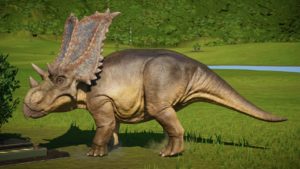common name: Chasmosaurus
Species: Dinosaur
Historical period: Late Cretaceous (about 75 to 70 million years ago)
Size: About 15 feet in length (4.57 m)
Weight: Weight up to 2 tons
Diet: Herbivores
Identification: Large size, large rectangular frill on top of head and 3 small horns on face
Fossil found in: New Mexico, Alberta ( Canada) and Saskatchewan (Canada)
Chasmosaurus is a genus of Ceratopsian dinosaur from Canada during the late Cretaceous period. It was first discovered in 1898 by Lawrence Morris Lambe in Alberta, Canada. In 1913, Lambe also found another species of this genus, so he decided to name all his finds Protorosaurus, but it was not long before he discovered that the name had already been given to a species. other reptiles of the 19th century. So in 1914, he decided to give it another name, Chasmosaurus, which in Greek means ” open lizard “. The name refers to the fact that this dinosaur had slits.
Some information about the dinosaur Chasmosaurus
Description Information
Chasmosaurus looks a lot like a rhinoceros . It has a large bony frill protruding from the back of its skull and three small horns on its face. The large frills are hardly used in combat because they are so fragile. Instead, the frills are brightly colored to attract mates or scare off predators and opponents.
Chasmosaurus is a medium-sized dinosaur with a thick body, a body length of about 4 to 5 m and a weight of up to 3.5 tons, with four short legs and a short tail. Although its snout had no teeth, Chasmosaurus had specially developed cheek teeth that were used to crush all kinds of different plants.

Calculation
There is an interesting fact about Chasmosaurus that has been discovered by paleontologists. For example, it is now known that this dinosaur hatched from eggs and could take care of those eggs. This is in stark contrast to what paleontologists usually think about dinosaurs. In the past, it was thought that these large animals did not take care of their young. And now that assumption is starting to turn into a completely false assumption.
Not only can take care of young, but Chasmosaurus is also very social. It often travels in large herds in search of food and increased protection against predators. Paleontologists believe that Chasmosaurus was able to defend itself in the same way that a rhinoceros would do by running at full speed and knocking off predators with its massive head. This was actually a very effective defense and probably helped this dinosaur against some of the carnivores of the time.
Diet
Chasmosaurus was a herbivore , so it ate so many different plants that it easily chewed that food source with its cheek teeth. Some of the major plants are seed ferns, cycads, and a few others.
Palaeontology
Chasmosaurus shared its habitat, the east coast of Lamramidia, with successive Centrosaurus species. A suitable partition for Chasmosaurus has a longer snout and jaw.
The horns and frills also cannot be used for defensive purposes because the horns are too short and the frills are too large to be defended. Paul thinks that the new mine is the main weapon of defense. Maybe frills are simply used to beautify and regulate body temperature.











